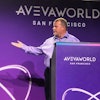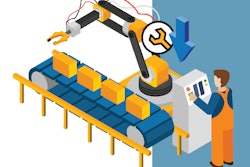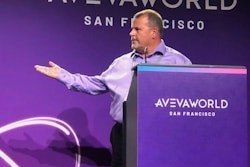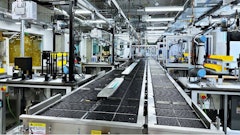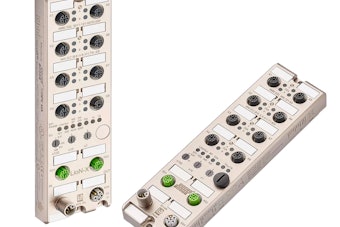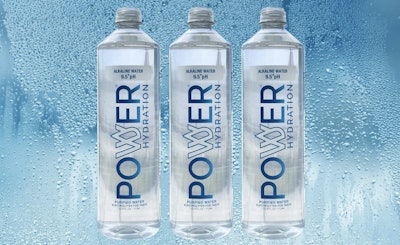
When new sustainably-focused health and wellness beverage brand Power Hydration introduced its alkaline water product to consumers in Southern California this summer, it assumed bragging rights for a first-of-its-kind closure that delivers enhanced aesthetics, improved recyclability, and better performance to the beverage industry. The closure, the PCO 1881 (28-mm) cap from Origin Materials, is the first commercially scalable PET cap for use with PET bottles, resulting in a fully recyclable, mono-material beverage package.
Says Power Hydration CEO Danny Helou, “We believe that what you drink should not only quench your thirst, but also fuel your body and support your lifestyle. As a forward-thinking wellness brand, we’re committed to innovation, sustainability, and transparency in everything we do, from our sourcing to our packaging.
“When I learned about the Origin PET closure, I was right on board because it aligned with our vision for the ‘ultimate in sustainability.’”
The new cap is the result of several years of R&D by Origin in the areas of PET cap and closure design and manufacturing, which Origin co-founder and co-CEO John Bissell says was undertaken to “help transition the world to more sustainable materials.”
The challenge of PET in closures
PET has long been the resin of choice for beverage bottles, but caps have typically been made of polyolefins such as high-density polyethylene or polypropylene. That difference has created complications for recyclers. When disposing of their beverage packaging, consumers are instructed to leave the caps on. As a result, HDPE and PP closures are often baled along with bottles after sorting at the MRF (municipal recycling facility). When the bottles are recycled, the caps typically separate out during the float-sink process, leaving material that is less likely to be reclaimed. PET caps, by contrast, add value to PET bales by remaining in the recycling stream.
“The cap is not a trivial part of the bottle weight. It can actually be as much as 10, 15, or 20% of the total weight of the packaging system,” says Bissell. “So adding 5% economic value to that bale [with PET caps] can be really significant. That could easily double the margin of some of the players in the recycling stream.”
So why has it taken so long to get a PET cap to market? The answer lies in the material properties of PET and its behavior during processing. “If you use PET in the exact same way you’d use a polyolefin like polypropylene or polyethylene, it just doesn’t behave the same way,” explains Bissell. “Specifically with PET, it doesn’t want to flow the same way when it’s melted. You can have pretty significant difficulties when using PET in injection-molding systems in getting the fine feature definition you want quickly for what is essentially a semi-precision part.
“With polyolefins, if they’re not flowing as fast as you want, you can just ramp up the temperature, and eventually they’ll do what you want as quickly as you want. For applications such as injection molding or compression molding, PET is a little bit more sensitive, and you’ve got to respect it a little more. So as a consequence, you don’t have that lever to force the issue with PET in those applications.”
To create the fine definition required of a beverage cap using PET means that the channels in the injection-molding tool must be larger, resulting in a thicker, heavier, and more costly closure.
The other characteristic of PET that makes it different from HDPE or PP is the performance of the cap itself. “What you get with PET is a much stronger and more rigid material, which has benefits, a lot of benefits, but it also means you need to design it differently,” adds Bissell.
Attempts to injection mold or compression mold PET caps date back at least a decade, but challenges around feature definition as well as cycle time and cap weight—both of which result in higher costs—prevented commercial success.
(Editor’s Note: In September, Australian company Nviro1 announced it had successfully created a prototype of an injection-molded 26-mm PET closure for water and CSD bottles. The company is currently seeking licensing and manufacturing partnerships; there are currently no commercial applications of the closure.)
Thermoforming unlocks PET’s potential
To create a scalable, lightweight, and economic PET closure, Origin took a new approach. The company is using thermoforming to manufacture the caps. “Thermoforming was a way for us to get that fine feature definition and speed of processing without the limitations of PET in injection molding,” says Bissell. “In fact, the differential properties of PET in thermoforming are beneficial.”
Thermoforming starts with a PET sheet that is heated and shaped into thin, resilient parts. According to Bissell, PET’s strength allows for thinner walls, which reduces weight—the caps are 1.5 to 1.8 g—without sacrificing performance. This approach also delivers faster cycle times. And, as Bissell explains, as cap sizes increase, the throughput advantage of thermoforming grows, with large-format PET caps produced at speeds unmatched by injection molding.
“Thermoforming gives you both a lighter cap and a much more quickly formed cap, both of which drive at the core economics of cap making,” says Bissell.
 According to Origin Materials co-CEO John Bissell, the new Origin PCO 1881 cap ‘looks better, it performs better, and it is better from a sustainability perspective.’Origin Materials
According to Origin Materials co-CEO John Bissell, the new Origin PCO 1881 cap ‘looks better, it performs better, and it is better from a sustainability perspective.’Origin Materials
The PET platform also offers advantages that go beyond sustainability. PET provides a higher oxygen barrier than polyolefins, extending the shelf life for oxygen-sensitive beverages like teas and juices. It also is a “better looking cap,” according to Bissell, and provides a crisp, satisfying opening experience.
“We say it looks better, it performs better, and it is better from a sustainability perspective,” Bissell shares. “So it’s aesthetics, performance, and sustainability.” He adds that he is not aware of any other company that offers thermoformed PET closures.
Building a manufacturing platform
To bring the technology to scale, Origin assembled a group of machine partners that engineered the CapFormer system. German company Illig provides the thermoformers, PackSys Global, part of the Brüeckner Group, adapted its slitting technology for PET, and IMDvista supplies optical inspection systems that check thousands of caps per minute. Origin contributed its own tooling designs and system integration.
Commercial production is underway in Reed City, Mich., where Origin partnered with Reed City Group to house its first CapFormer lines. In February, when the first line became operational, Bissell said, “Producing PET closures at commercial volumes on the first Origin CapFormer System in our production center in Michigan is just an awesome milestone. This first CapFormer line is meeting all of our expectations and is expected to produce hundreds of millions of PET caps each year.”
Origin is in the process of installing two more lines with additional lines planned for the near future. The company owns the equipment and has engineers on-site, while Reed City provides the space, the utilities, and the manufacturing expertise. Origin also recently announced a manufacturing partnership with Royal Hordijk in Europe, a company that is highly experienced with thermoforming and working with PET.
“So, by the end of the year, we should be capable of supplying regionally any brand, no matter the scale,” says Bissell. “Obviously, we’re not going to dedicate all our caps to a single brand. That’s not the expectation. But we have enough to make a difference, let’s put it that way.”
Power Hydration as First Adopter
Power Hydration’s journey to become the first beverage company to adopt the thermoformed beverage cap began through a mutual contact. The use of the cap, Helou explains, aligned with both the company’s high product standards and its sustainable packaging strategy.
To differentiate its product from competitive alkaline waters, Power Hydration filters its PH water “way above industry micro standards,” just before entering the filler, says Helou. “The RO [reverse osmosis] system is beyond the capacity required to ensure the highest quality of water before converting to 9.5PH,” he adds. “Our PH concentrate is produced by a U.S. company located within 20 miles of our filling facility. We do not import finished concentrate from abroad; we know the source of our ingredients.”
For its packaging, the company uses a wash-off label on its beverage bottle to maximize the quality of the reclaimed PET during the recycling process and is trialing a recyclable bioplastic stretch film for its pallets. Helou says his vision is a 100% recyclable bottle, including the highest recycled content. “This is a very small part of the bigger picture,” he says. “We have other significant initiatives that are a bit too early to share.”
The cap used by Power Hydration is compatible with a PCO 1881 neck finish, which is a widely used closure for both still and carbonated beverages. According to Bissell, qualifying the cap for Power Hydration’s filling line was a simple process since “they weren’t locked into any particular cap setting.” Implementation of the PET cap on existing filling lines requires no changes in parts, just adjustments to operating parameters.
Power Hydration alkaline water is currently sold in more than 40 gas station and convenience stores in Southern California. By the end of 2025, it will be in more than 300 locations, and by Q2-26, it will be in stores in Nevada and Arizona. “With great consumer feedback, Power Hydration is focusing on the right distributors for nationwide distribution,” says Helou.
A market opportunity worth billions
Caps and closures represent a $65 billion global market. By unlocking PET for closures, Origin believes it can offer a mono-material solution for most beverage categories. “We think it’s pretty unlikely that there’s an application that you can’t use a PET cap for, or if there is, it’s a relatively small or niche application,” says Bissell.
The company is initially pursuing smaller, flat-water customers, then will follow with CSD brands, which take longer to qualify. After gaining proficiency in the 1881 cap, it plans to develop other closure formats. The current cap can be produced with virgin PET, rPET, or bio-based PET and in a tethered style.
For now, Origin is excited to see the first launch of its PET caps with Power Hydration, a milestone that demonstrates how smaller, nimble brands can lead the way. As production expands and larger customers qualify the technology, PET caps could become a new standard in beverage packaging.
Says Bissell, “Origin’s 1881 closure and Power Hydration’s launch are emblematic of the industry’s transition toward mono-material PET packaging solutions offering full recyclability—including the cap—and beautiful transparency, made with PET from cap to bottom.” PW



